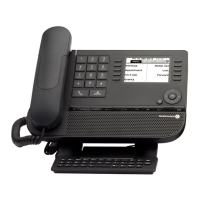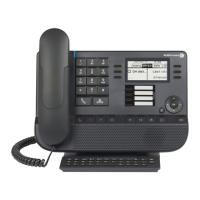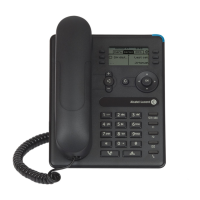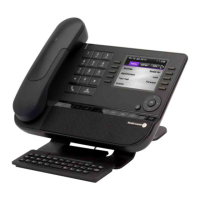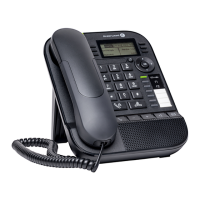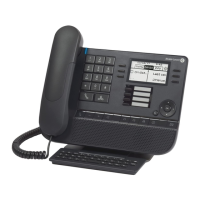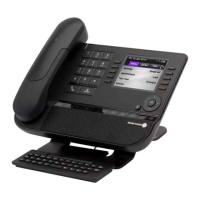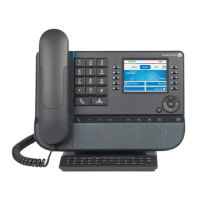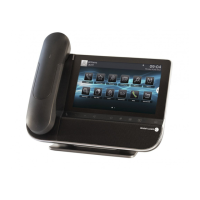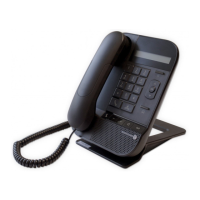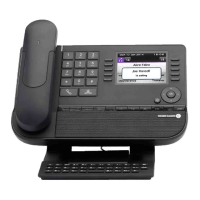
Do you have a question about the Alcatel-Lucent 8039 and is the answer not in the manual?
| Handset | Yes |
|---|---|
| Speakerphone | Yes |
| Bluetooth | No |
| Wi-Fi | No |
| USB Port | No |
| Ethernet Ports | 2 |
| Handsfree | Yes |
| Network Interfaces | 10/100 Mbps Ethernet |
| Supported Protocols | SIP |
| Codecs | G.711, G.729 |
| Power Supply | PoE (Power over Ethernet) |
| Headset Port | RJ-9 |
| Audio | HD audio quality |
| Keys | 6 programmable keys |
| Navigation | 4-way navigation key |
| Resolution | 128 x 64 pixels |
| Memory | NA |
Overview of the 8068 Bluetooth and standard models.
Overview of the 8038 and 8039 models.
Overview of the 8028 and 8029 models.
Details of the various connectors available on the phone models.
Explanation of the phone's welcome screens and their functions.
Guide to using the phone's navigation keys and menus.
Explanation of icons used for phone status and call information.
Description of the phone's fixed function keys and their uses.
Details on using the alphabetic keyboard for input and features.
Instructions for installing and connecting add-on modules.
How to manage calls using the phone's display screen.
Information on the Bluetooth handset, its features, and LED indicators.
Guide to initiating phone calls using various methods.
How to answer incoming phone calls.
Instructions for operating the phone in hands-free mode.
How to use the loudspeaker during an active call.
How to call contacts using the company directory.
Using pre-programmed keys for making calls.
Using the voice mailbox to filter incoming calls.
How to redial the last number or access the redial list.
How to request an automatic callback for busy internal lines.
Procedure for canceling a pending automatic callback.
How to answer intercom calls directly.
How to send DTMF signals for automated systems.
How to mute the microphone during a call.
Steps to start a multi-person conference call.
How participants can join an ongoing conference call.
How to receive special ringing for calls to another number.
How to answer general calls when the operator is absent.
How to filter calls between managers and assistants.
How to answer a call ringing on another phone in your group.
How to answer operator calls directly from your phone.
How to make calls to hunting groups.
How to page an internal caller who doesn't answer.
How to answer a paged call from any phone.
How to activate a caller's loudspeaker if they don't answer.
How to send text messages to internal users.
How to copy and send a voice message.
How to send recorded messages to groups.
How to broadcast messages to multiple phones.
How to choose which calls to forward (internal, external, all).
Setting up immediate call forwarding to another number.
How to forward calls directly to your voicemail.
Accessing and managing voice messages upon return.
How to activate or deactivate the personal assistant feature.
Setting up the personal assistant to route calls to a single number.
How to forward calls to a pager for mobile contact.
Setting up call forwarding to follow you to another terminal.
How to forward all calls from a group to another number.
Steps to deactivate all existing call forwarding rules.
How to cancel a single, specific call forward.
Setting up call forwarding when the line is occupied.
How to enable the "Do Not Disturb" feature.
How to leave a recorded message for internal callers.
How to read and manage received text messages.
How to receive notifications for new messages on another phone.
How to bill outside calls to business account numbers.
How to check call costs for internal users.
Steps to set up and initialize the voicemail box.
How to record and set a personal greeting message.
How to change the personal code for security.
How to adjust ringer volume, melodies, and modes.
How to set screen and key contrast for specific models.
How to choose the default page displayed on the phone.
How to select the preferred language for the phone interface.
Setting up speed dial keys on the Perso page.
Removing programmed direct call keys from the Perso page.
Setting up speed dial keys for F1 and F2 functions.
Removing programmed direct call keys from F1/F2.
Setting up programmable keys for 8028/8029 models.
Removing programmable keys for 8028/8029 models.
Setting up reminders for appointments.
How to find the phone's current number.
How to lock and unlock the phone for security.
Setting up the audio jack for headset or speakerphone.
Enabling or disabling the forced headset mode.
Pairing a Bluetooth handset with the phone.
Operating the Bluetooth handset, including LED indicators.
Pairing a Bluetooth headset with the phone.
Referencing user documentation for Bluetooth headsets.
Removing paired Bluetooth devices.
Information on contacting support for phone issues.
Introduction to the agent set for call center operations.
Steps to log in and start an agent session.
Overview of the agent application's main screen.
Explanation of agent availability statuses (On duty, Off duty, etc.).
How agents can change their work status.
Changing the personal code for agent login.
Managing group assignments for agents.
Steps to log out and end an agent session.
Introduction to the supervisor role and capabilities.
How supervisors monitor group voice mailboxes.
Important safety precautions for using the equipment.
Regulatory compliance information and declarations.
